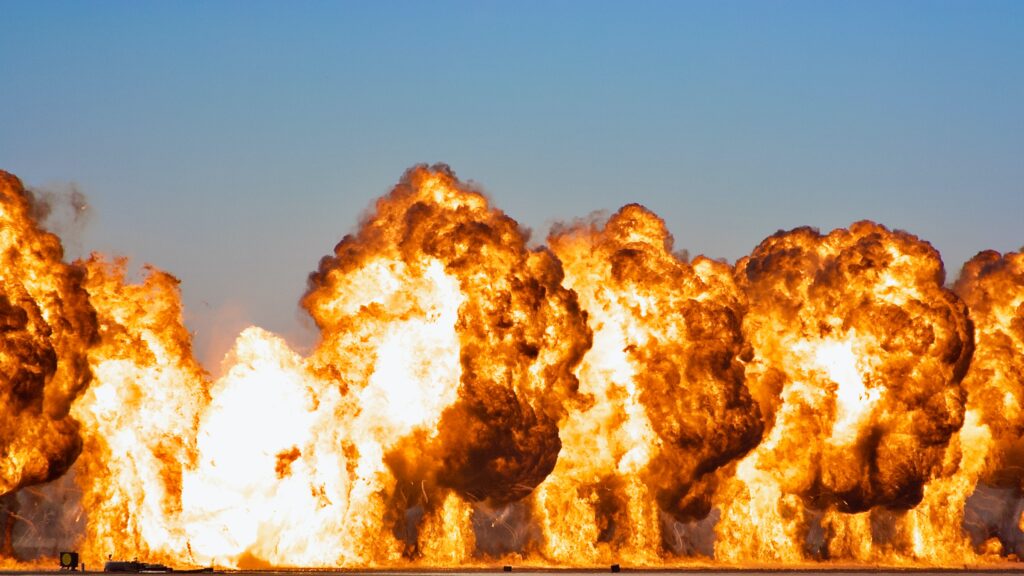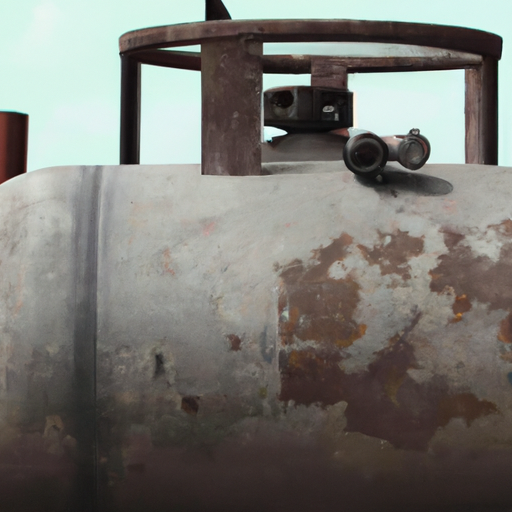Imagine this scenario: you’re working in your garage, happily using your air compressor to power your tools, when suddenly a chilling thought crosses your mind – can air compressor tanks actually explode? You pause for a moment, contemplating the potential dangers lurking in your trusty tool. In this article, we’ll explore the risks and shed light on whether or not air compressor tanks can indeed explode. So, buckle up and prepare to uncover the truth behind this potentially concerning question.
Understanding Air Compressor Tanks
What are air compressor tanks?
Air compressor tanks are essential components of pneumatic systems. They serve as storage vessels for compressed air to be used in various applications such as powering tools and equipment. These tanks are designed to withstand high pressure and store the compressed air safely until it is needed. They come in different shapes and sizes, ranging from small portable tanks to large stationary tanks.
Typical materials used for air compressor tanks
Air compressor tanks are typically made from steel or aluminum alloys. Steel tanks are commonly used due to their durability, strength, and resistance to corrosion. They are often coated with protective paint or enamel to further enhance their resistance to rust. Aluminum tanks, on the other hand, offer advantages such as lightweight construction and resistance to corrosion. However, they may not be as durable as steel tanks.
Role of air compressor tanks in pneumatic systems
Air compressor tanks play a crucial role in pneumatic systems. When an air compressor operates, it compresses and stores air in the tank. This compressed air can then be released on demand to power tools or other pneumatic devices. The tank acts as a reservoir, ensuring a steady supply of compressed air, reducing pressure fluctuations, and improving system performance. Additionally, the tank aids in moisture separation, allowing any moisture in the compressed air to condense and be drained from the tank.
Operating Pressure and Safety Factors
Understanding operating pressure
Operating pressure refers to the pressure at which an air compressor is set to operate. The operating pressure is typically determined based on the requirements of the pneumatic system and the tools or equipment being used. It is crucial to set the operating pressure within the recommended range specified by the manufacturer to prevent overpressurization of the tank.
Safety factors considered in air compressor tank design
When designing air compressor tanks, safety factors are taken into account to ensure their structural integrity and prevent accidents. These safety factors include factors of safety, which are ratios comparing the actual maximum operating pressure to the yield strength of the tank material. The selection of suitable materials, thickness, and construction methods are also critical in the design process.
Types of pressure relief mechanisms
Pressure relief mechanisms are essential safety features incorporated into air compressor tanks. They are designed to release excess pressure to prevent the tank from overpressurizing and potentially exploding. The most common type of pressure relief mechanism is a pressure relief valve. This valve is set to open when the pressure inside the tank exceeds a predetermined limit, allowing the excess pressure to escape and alleviate the risk of explosion. Other pressure relief mechanisms include burst discs and fusible plugs, which activate when specific temperature or pressure thresholds are exceeded.

Causes of Air Compressor Tank Explosions
Overpressurization of the tank
One of the primary causes of air compressor tank explosions is overpressurization. If the pressure inside the tank exceeds its maximum rated capacity, the tank may rupture or explode. Overpressurization can occur due to factors such as incorrectly set pressure regulators, malfunctioning pressure relief valves, or human error in adjusting the operating pressure.
Weaknesses in tank design or manufacturing
In some cases, air compressor tank explosions can be attributed to weaknesses in tank design or manufacturing. Poor welds, inadequate materials, or structural defects can compromise the tank’s integrity and increase the likelihood of failure under pressure. Proper tank design, materials selection, and quality control during manufacturing are essential in minimizing these risks.
Corrosion and rusting
Corrosion and rusting pose significant risks to air compressor tanks. Over time, exposure to moisture, humidity, and other corrosive elements can lead to the deterioration of the tank’s structural integrity. Weakened areas may develop rust or corrosion, which can eventually compromise the tank’s ability to withstand pressure and lead to catastrophic failure. Regular inspection, maintenance, and proactive measures to prevent corrosion are vital in preventing tank explosions.
Inadequate maintenance and inspection
Neglecting regular maintenance and inspection routines can contribute to air compressor tank explosions. Without proper care, issues such as leaks, worn-out parts, or deteriorating seals may go unnoticed. Failures in these components can result in increased pressure, weakening the tank over time and significantly increasing the risk of explosion. Maintaining a regular maintenance schedule and conducting thorough inspections are critical preventative measures.
Signs and Warnings
Unusual noises or vibrations
Unusual noises or vibrations coming from the air compressor tank should never be overlooked. These may indicate underlying problems such as loose fittings, damaged valves, or excessive pressure buildup. If you notice any unexpected sounds or vibrations, it is crucial to investigate and address the issue promptly to prevent potential tank failures.
Leaking air or pressure drops
Leaks in the tank or drop in air pressure can be signs of a failing air compressor tank. If you observe a constant need to refill the tank more frequently than usual or notice air escaping from fittings or connections, it indicates a potential problem. Leaks can weaken the tank’s structural integrity and increase the risk of an explosion. Identifying and repairing leaks promptly is essential to prevent further damage.
Visible corrosion or rust
Visible signs of corrosion or rust on the tank’s surface should not be ignored. Corrosion weakens the tank over time, making it more prone to failure and potential explosion. Regularly inspect the tank for any signs of corrosion or rust and take appropriate measures to address and prevent further deterioration.
Inconsistent pressure readings
Monitoring and maintaining consistent pressure readings are crucial in ensuring the safe operation of an air compressor tank. If you notice inconsistent pressure readings or fluctuations, it may indicate underlying issues with the tank, pressure relief mechanisms, or other components. Investigating and addressing these discrepancies promptly is essential to minimize the risk of tank explosions.

Preventing Air Compressor Tank Explosions
Proper installation and setup
Proper installation and setup of air compressor tanks are essential for safe operation. Follow the manufacturer’s guidelines and recommendations for installation, including proper positioning, securing, and connecting the tank. Ensure that all fittings, hoses, and connections are tightened correctly and free from leaks. Adhering to proper installation practices sets a solid foundation for safe and efficient operation.
Regular inspection and maintenance
Regular inspection and maintenance are crucial in preventing air compressor tank explosions. Establish a maintenance schedule that includes routine checks for leaks, corrosion, worn-out parts, and abnormal performance. Inspect and test pressure relief mechanisms regularly to ensure they are functioning correctly. Any issues or signs of deterioration should be addressed promptly to prevent further damage and potential tank failures.
Replacement of worn-out or damaged parts
Worn-out or damaged parts, such as seals, valves, or pressure relief mechanisms, should be replaced promptly. These components play vital roles in maintaining the tank’s integrity and preventing overpressurization. Regularly inspect these parts and replace them as needed to ensure the safe operation of the air compressor tank.
Ensuring correct pressure ratings
It is essential to ensure that the air compressor tank has the correct pressure ratings for the intended application. Operating the tank at pressures beyond its capacity can lead to catastrophic failure. Always follow the manufacturer’s recommended pressure ratings and avoid exceeding them. Using pressure gauges and regulators can help monitor and control the operating pressure to maintain safe conditions.
Using pressure relief valves
Pressure relief valves are critical safety devices that help prevent tank explosions. Ensure that the air compressor tank is equipped with a properly sized and functioning pressure relief valve. Make sure it is set to the manufacturer’s recommended pressure release limit. Regularly inspect, test, and replace pressure relief valves as needed to ensure their effectiveness in relieving excess pressure.
Safety Measures and Protocols
Safe operating practices
Adhering to safe operating practices is essential in preventing air compressor tank explosions. Follow the manufacturer’s guidelines for proper operation, including operating pressure, duty cycle, and recommended use. Avoid overloading the tank or running it continuously beyond its recommended duty cycle. Taking proper precautions and understanding the limitations of the equipment are crucial in maintaining safe operating conditions.
Proper training and certification
Obtaining proper training and certification in operating air compressor tanks is paramount to safety. Proper training ensures that operators understand the potential risks, safety protocols, and correct operation techniques. Certification programs provide a standardized level of knowledge and competence, ensuring that operators are adequately prepared to operate air compressor tanks safely.
Personal protective equipment (PPE)
When working with air compressor tanks, wearing appropriate personal protective equipment (PPE) is important to minimize the risk of injury. PPE may include safety glasses, gloves, hearing protection, and respiratory protection when working in environments with airborne contaminants. Ensuring that the appropriate PPE is used during tank operation and maintenance helps safeguard operators from potential hazards.
Emergency response procedures
In the event of an air compressor tank failure or explosion, having well-defined emergency response procedures is crucial. Develop and communicate clear protocols for evacuating the area, notifying emergency services, and providing medical assistance if needed. Regularly review and practice these procedures to ensure everyone involved is prepared to respond effectively and minimize the impact of an incident.

Case Studies of Air Compressor Tank Explosions
Overview of notable incidents
Several notable incidents involving air compressor tank explosions have occurred over the years. These incidents have resulted in injuries, fatalities, and substantial property damage. Each case study provides valuable insights into the causes, consequences, and lessons learned from these incidents.
Analysis of causes and consequences
Analyzing the causes and consequences of air compressor tank explosions in case studies helps identify common factors leading to such incidents. Factors such as overpressurization, inadequate maintenance, design flaws, or manufacturing defects often contribute to these accidents. Understanding these causes allows for the implementation of preventive measures and industry improvements.
Lessons learned and industry improvements
The analysis of case studies involving air compressor tank explosions leads to valuable lessons learned and industry improvements. These incidents serve as reminders to prioritize safety, rigorous inspections, proper maintenance, and compliance with regulations and standards. Learning from past mistakes helps prevent future accidents and fosters continuous improvement within the industry.
Regulations and Standards
Government regulations and guidelines
Government regulations and guidelines play a significant role in ensuring the safety of air compressor tanks. Regulatory bodies establish and enforce standards to guide the design, manufacturing, installation, and operation of these tanks. Compliance with these regulations is essential for manufacturers, installers, and users to maintain safe practices and prevent accidents.
Industry-specific standards
In addition to government regulations, various industry-specific standards exist to provide further guidance on air compressor tank safety. Organizations such as the American Society of Mechanical Engineers (ASME) and the Occupational Safety and Health Administration (OSHA) have developed standards and codes specific to air compressor tanks. These standards outline requirements for design, construction, installation, inspection, and testing of these tanks to ensure their safe operation.
Role of inspections and certifications
Inspections and certifications play a critical role in ensuring the safety and compliance of air compressor tanks. Regular inspections help identify potential issues or deficiencies that may lead to tank failures. Inspectors verify compliance with applicable regulations and industry standards, providing assurance that the tanks meet the necessary safety requirements. Certification programs provide additional validation of compliance and demonstrate a commitment to safety.

Comparing Air Compressor Tanks with Other Pressurized Containers
Differences in design and application
Air compressor tanks differ in design and application compared to other pressurized containers. Unlike other containers that store gases or liquids, air compressor tanks store compressed air, which requires different considerations such as pressure ratings, moisture separation, and constant supply. This distinction in design and application highlights the unique challenges and safety considerations specific to air compressor tanks.
Explosion risks and safety features
Air compressor tanks and other pressurized containers have different levels of explosion risks and safety features. Air compressor tanks are specifically designed to withstand high pressures and have built-in safety mechanisms such as pressure relief valves. Other pressurized containers may have different materials and designs, which may impact their explosion risks and the safety features incorporated into them. Understanding these differences is crucial in promoting proper safety practices for each type of container.
Conclusion
Understanding air compressor tanks and the potential risks of explosions is essential for maintaining a safe working environment. By comprehending the causes of air compressor tank explosions and implementing the necessary safety measures, operators can minimize the risk of accidents and ensure the reliability and longevity of these critical components. Regular inspection, maintenance, adherence to regulations and standards, and proper training are key pillars of preventing air compressor tank explosions and promoting a culture of safety within the pneumatic industry.


